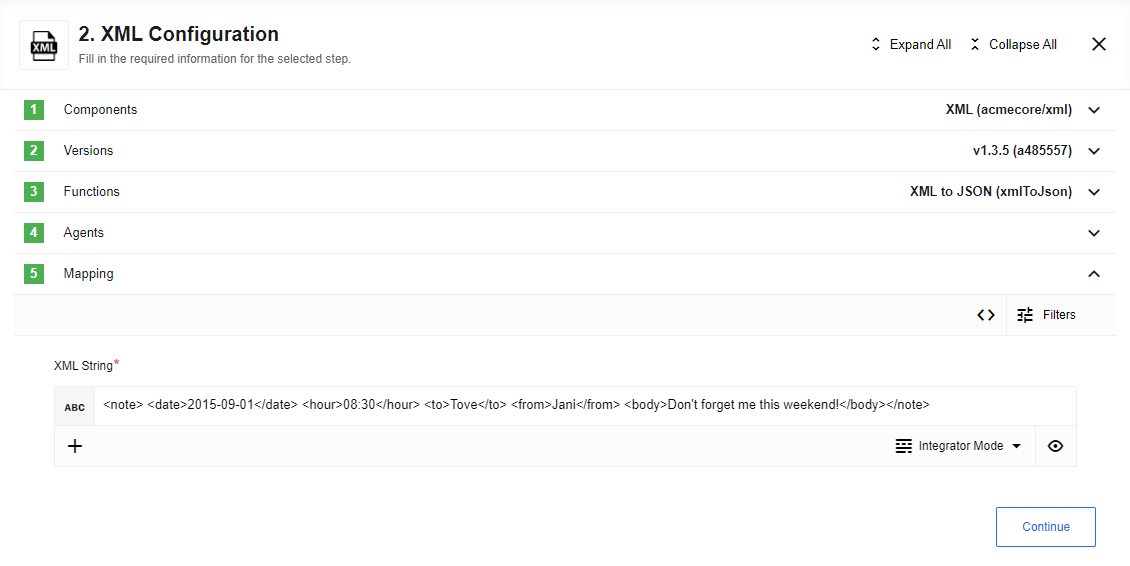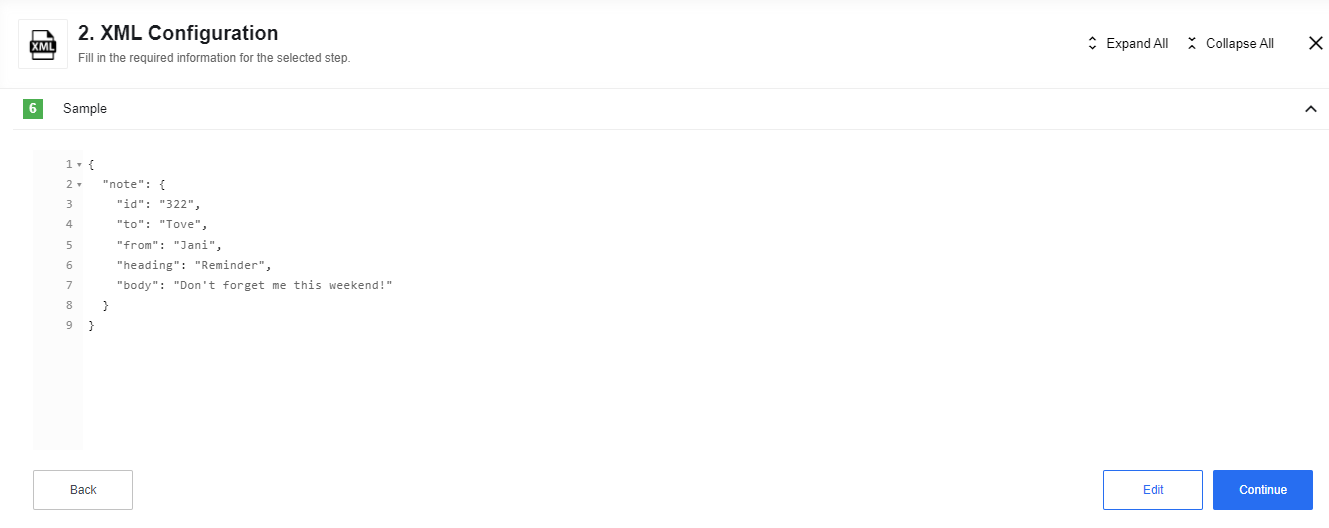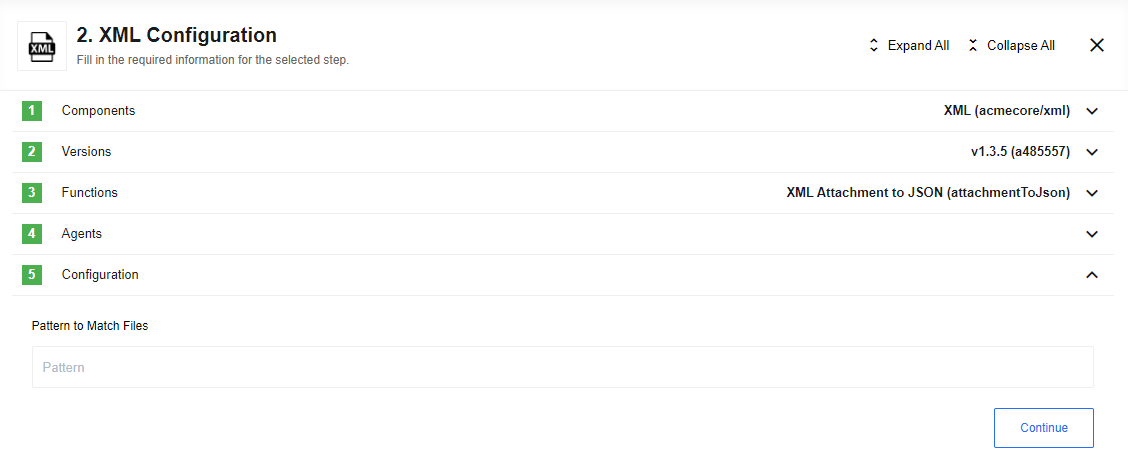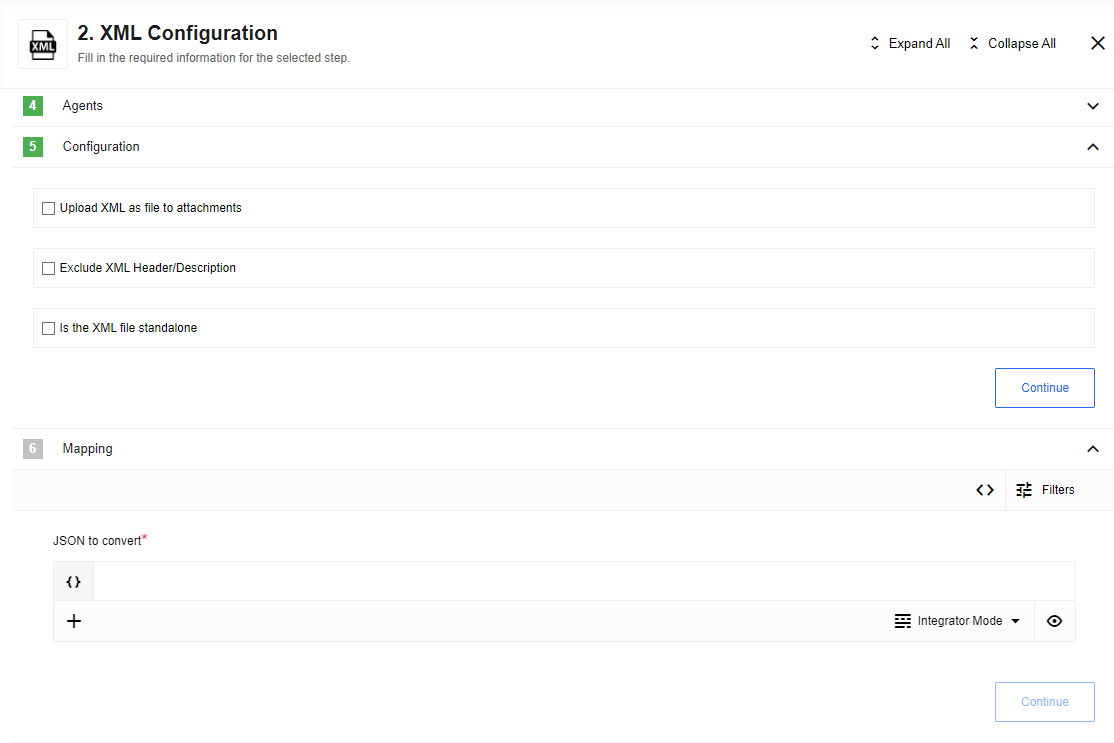XML component
Requirements and Conversion Behavior
Provided XML document (for XML to JSON) should be well-formed in order to be parsed correctly. You will get an error otherwise.
JSON inputs must be objects with exactly one field as XML documents must be contained in a single ‘root’ tag. JSON inputs can not have any field names which are not valid as XML tag names:
- They must start with a letter or underscore
- They cannot start with the letters xml (or XML, or Xml, etc)
- They must only contain letters, digits, hyphens, underscores, and periods
XML attributes on a tag can be read and set by setting an _attr sub-object in the JSON.
The inner-text of an XML element can also be controlled with # sub-object.
Click to expand for more details
For example:
{
"someTag": {
"_attr": {
"id": "my id"
},
"_": "my inner text"
}
}
is equivalent to
<someTag id="my id">my inner text</someTag>
Environment variables
-
MAX_FILE_SIZE: optional - Controls the maximum size of an attachment to be read or written in MB. Defaults to 10 MB where 1 MB = 1024 * 1024 bytes. -
EIO_REQUIRED_RAM_MB: optional - You can increase memory usage limit for component if you going to work with big files Defaults to 256 MB where 1 MB = 1024 * 1024 bytes.
Trigger
This component has no trigger functions. This means you can not select it as a first component during the integration flow design.
Actions
It allows users to convert XML attachments and strings to and from JSON. This component has 3 actions allowing users to pass in either generic but well-formatted XML/JSON strings or XML attachments and produces a generic string or attachment of the other file type. The output then can be mapped and used in other components.
XML to JSON
Takes XML string and converts it to a generic JSON object.
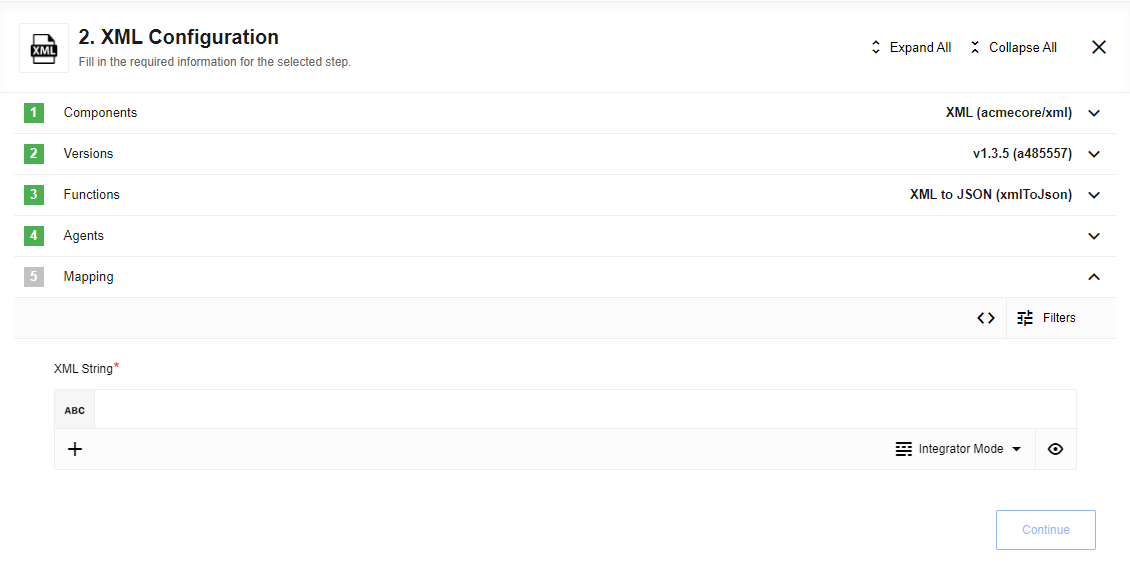
Limitation
Value inside xml tags will be converting into string only. It means that first, you need to convert string numbers - to numbers.
$number("5")=>5["1", "2", "3", "4", "5"].$number()=>[1, 2, 3, 4, 5]
Click to expand for more details
given xml
<note>
<date>2015-09-01</date>
<hour>08:30</hour>
<to>Tove</to>
<from>Jani</from>
<body>Don't forget me this weekend!</body>
</note>
will be converted into:
{
"note": {
"id": "322",
"to": "Tove",
"from": "Jani",
"heading": "Reminder",
"body": "Don't forget me this weekend!"
}
}
XML Attachment to JSON
Looks at the JSON array of attachments passed in to component and converts all
XML that it finds to generic JSON objects and produces one outbound message per
matching attachment. As input, the user can enter a patter pattern for filtering
files by name or leave this field empty for processing all incoming *.xml files.
Configuration Fields
- Pattern - (string, optional): RegEx for filtering files by name provided via old attachment mechanism (outside message body)
- Upload single file - (checkbox, optional): Use this option if you want to upload a single file
Input Metadata
If Upload single file is checked, there will be 2 fields:
- URL - (string, required): link to file on the Internet or platform
If Upload single file is unchecked:
- Attachments - (array, required): Collection of files to upload, each record contains object with two keys:
- URL - (string, required): link to file on the Internet or platform
If you going to use this option with static data, you need to switch to Developer mode
Sample
{
"attachments": [
{
"url": "https://example.com/files/file1.xml"
},
{
"url": "https://example.com/files/file2.xml"
}
]
}
Output Metadata
Resulting JSON object
JSON to XML
Provides an input where a user provides a JSONata expression that should evaluate to an object to convert to JSON. See Requirements & Conversion Behavior for details on conversion logic.
When creating XML files with invalid XML tags, the name of the potentially invalid tag will not be reported. XML tags are case-sensitive. The tag <Text> is different from the tag <text>.
Opening and closing tags must be written with the same case:
<message>Hello, World!</message>
The following options are supported:
Click to expand for more details
-
Upload XML as file to attachments: When checked, the resulting XML will be placed directly into an attachment. The attachment information will be provided in both the message’s attachments section as well as
attachmentUrlandattachmentSizewill be populated. The attachment size will be described in bytes.
When this box is not checked, the resulting XML will be provided in thexmlStringfield. -
Exclude XML Header/Description: When checked, no XML header of the form
<?xml version="1.0" encoding="UTF-8" standalone="no"?>will be prepended to the XML output. -
Is the XML file standalone: When checked, the xml header/description will have a value of
yesfor standalone. Otherwise, the value will beno. Has no effect when XML header/description is excluded.
The incoming message should have a single field input. When using integrator mode, this appears as the input JSON to convert When building mappings in developper mode, one must set the input property. E.g.:
{
"input": {
"someTag": {
"_attr": {
"id": "my id"
},
"_": "my inner text"
}
}
}
Usage Example
We have created a special document that contains an example to better understand how the XML component works.
Known limitations
- The maximum size of incoming file for processing is 5 MB. If the size of incoming file will be more than 5 MB, action will throw an error:
Attachment *.xml is to large to be processed my XML component.
File limit is: 5242880 byte, file given was: * byte
- All actions involving attachments are not supported on local agents due to current platform limitations.
- When creating XML files with invalid XML tags, the name of the potentially invalid tag will not be reported.
- When you try to retrieve a sample in
XML Attachment to JSONaction and it’s size is more than 500Kb, there will be generated new smaller sample with the same structure as original
Click here to learn more about the elastic.io iPaaS
